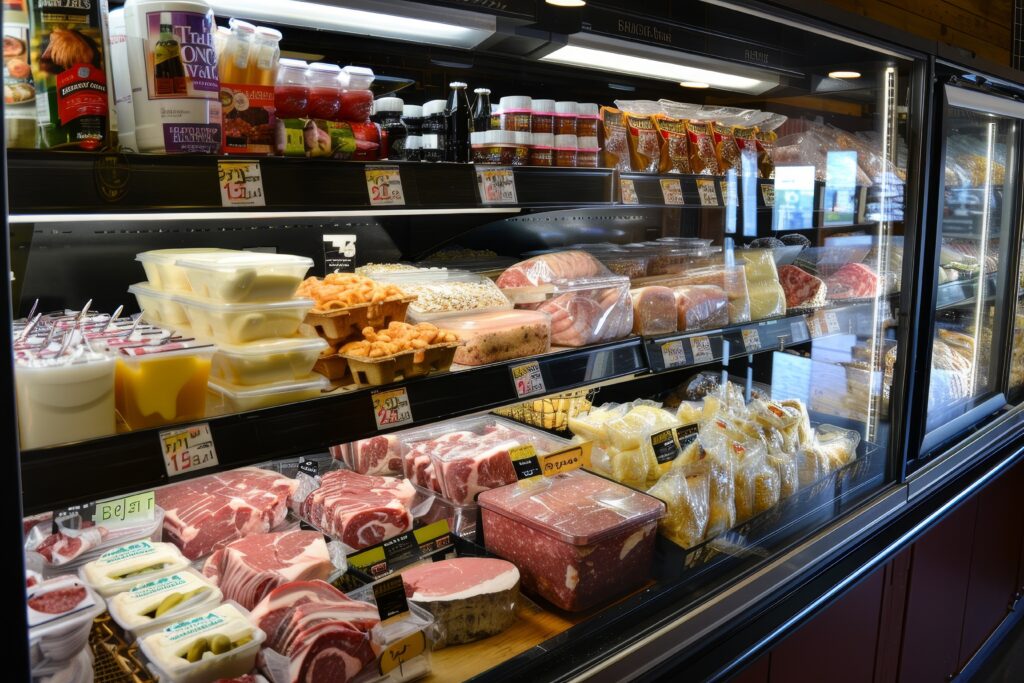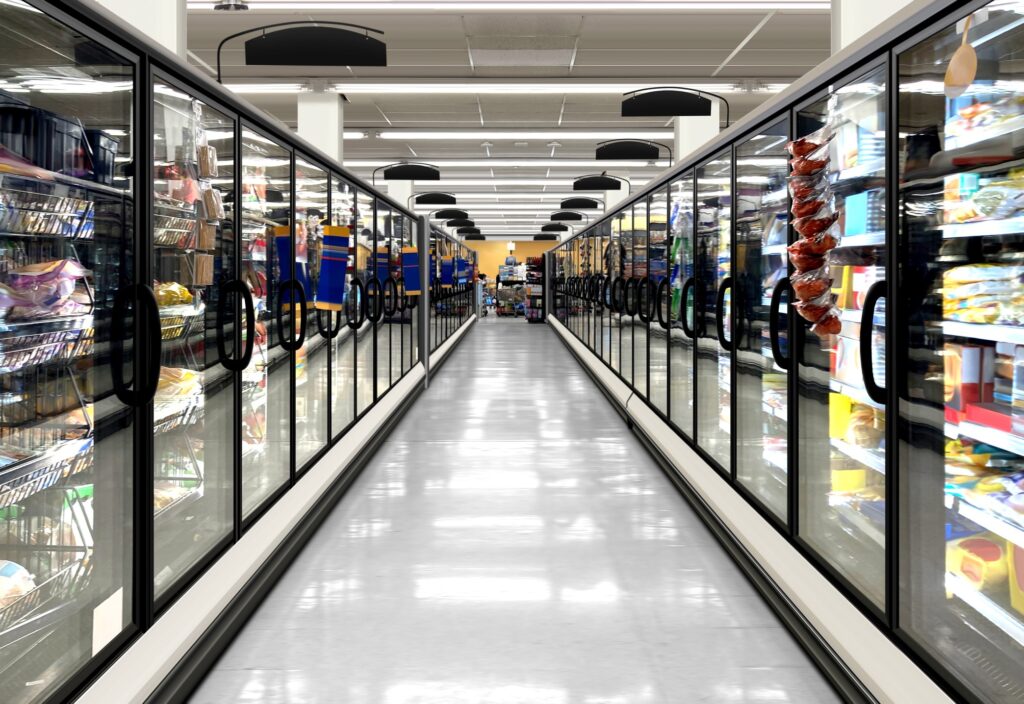
Given the impact supermarkets and other food retailers have on the environment, as the world focuses more on sustainability, facilities managers in this sector can expect to face stricter regulations aimed at reducing greenhouse gas emissions — especially those originating from HFC refrigerants — in the coming years.
Used in refrigeration and HVAC systems, HFCs (hydrofluorocarbons) are potent greenhouse gasses. According to the EPA, they have GWPs (global warming potentials — a measure of the relative climate impact of a greenhouse gas) that can be hundreds to thousands of times higher than that of CO2 (carbon dioxide).
As mandated by the AIM (American Innovation and Manufacturing) Act of 2020, the Environmental Protection Agency is authorized to regulate the phasedown of HFCs as part of the mandated transition to more environmentally friendly alternatives. The ultimate goal is to reduce certain HFCs by 85% of their historical baseline by 2036.
As part of this phasedown, the food retail industry is poised to undergo a rapid transition to climate-friendly alternatives over the next decade. For the latest EPA refrigerant regulations, here’s what you need to know.*
New EPA Refrigerant Regulations 2023
Emission Reductions and Reclamation Program
Automatic Leak Detection (ALD) Systems Regulations
New EPA Refrigerant Regulations 2025
Tips for Navigating the New EPA Refrigerant Regulations
Background: AIM ACT 2020
The AIM Act of 2020 marked a major milestone in sustainability legislation by authorizing the EPA to assist with the transition from HFCs to climate-friendly refrigerants in alignment with the global Kigali Amendment to the Montreal Protocol — an international agreement adopted in 2016 by 197 developed and developing countries to phase down HFCs.
EPA Refrigerant Phase Out Schedule
The AIM Act has set the following phase out schedule for HFC production and consumption:
- 2020–2023: 90% of historical levels
- 2024–2028: 60% of historical levels
- 2029–2033: 30% of historical levels
EPA Refrigerant Laws
Since 2016, several regulations have been signed into law for the industries governed by the AIM Act. These include:
- Allocation Framework Rule (October 2021): Set baselines for HFCs as a starting point for the transition to climate-friendly alternatives
- Allowance Allocation Methodology (July 2023): Established a methodology for how emissions allowances will be determined for facilities and entities
- Technology Transitions (October 2023): Established restrictions on new products and equipment using high-GWP HFCs as part of the phased transition to lower-GWP alternatives starting January 1, 2025
- Emissions Reduction and Reclamation Program (October 2023): Proposed specific measures for reducing greenhouse gas emissions including leak repair and ALD (automatic leak detection) systems regulations
New EPA Refrigerant Regulations 2023
2023 was a momentous year in terms of climate change legislation — various iterations of EPA rules were proposed, finalized, and updated under the provision or subsection within the AIM Act of 2020 titled “Phasedown of Hydrofluorocarbons: Restrictions on the Use of Certain Hydrofluorocarbons under Subsection (i) of the American Innovation and Manufacturing Act of 2020.”
Here’s what happened:
Timeline:
- On October 5, 2023, EPA finalized the proposed rule known as the Technology Transitions Program.
- In October 2023, the EPA also released the proposed rule known as the Emissions Reduction and Reclamation Program, requesting feedback by December 18, 2023. As of now, the final rule has yet to be released.
- On December 26, 2023, the EPA published an interim final rule for the Technology Transitions Program, updating its October final rule on HFCs. This extended the compliance deadline to January 1, 2026 for systems using components that were manufactured or imported before January 1, 2025.
These new EPA refrigerant regulations in 2023 covered a lot of ground. Here are some of the most important takeaways for grocers and other food retailers:
Technology Transitions: New EPA Refrigerant Regulations 2023
In its aim to help industries transition to lower-GWP refrigerants, the rule covers restrictions on the manufacture, import, installation, and labeling of products and equipment using an HFC or HFC blend with high GWP. A phased-in approach was adopted for refrigeration and cooling units with final effective dates depending on the type of equipment.
Below you’ll find a list of some of the restricted products. For a complete list, refer to the Technology Transitions Fact Sheet.
Manufacture and Import
Manufacture and import of the following is prohibited after these effective dates:
- January 1, 2025
| Product | GWP of HFC or HFC blend required |
| Retail food refrigeration units | 150 or higher |
| Chillers for comfort cooling | 700 or higher |
| Specified types of refrigerated transport | 700 or higher |
| Specified types of foam products | 150 or higher |
| Specified types of aerosol products | 150 or higher |
- January 1, 2026
| Product | GWP of HFC or HFC blend required |
| Specified ice maker products above a harvest rate threshold | 150 or higher |
| Chillers for certain industrial process refrigeration | 150 or 300 or 700 or higher (depending on the type) |
| Retail food remote condensing units | 150 or 300 (depending on the type) |
Installation
Installation of the following is prohibited as follows by these effective dates:
- January 1, 2025
| Product | GWP of HFC or HFC blend required |
| Chillers for comfort cooling | 700 or higher |
| Specified refrigerated transport | 700 or higher |
| Retail food refrigeration stand-alone units | 150 or higher |
- January 1, 2026
| Product | GWP of HFC or HFC blend required |
| Chillers for industrial process refrigeration | 700 or higher |
| Specified cold storage warehouse systems | 150 or higher, or 300 or higher (depending on the type)
|
| Cascade refrigeration systems | 300 or higher |
| Specified industrial process refrigeration systems** | 150 or higher, or 300 or higher, depending on the type |
**The compliance date has been extended by one year with an approved building permit issued prior to October 5, 2023 specifying the use of an HFC or HFC blend.
- January 1, 2027
- Specified supermarket systems using an HFC or HFC blend with a GWP of 150 or higher or 300 or higher (depending on the type) and cascade refrigerant systems that use an HFC or HFC blend with a GWP of 300 or higher
- January 1, 2028
- Chillers for certain industrial process refrigeration using an HFC or HFC blend with a GWP of 700 or higher
- Industrial process refrigeration systems (besides chillers) using an HFC or HFC blend with a GWP of 700 or higher
- January 1, 2027 or January 1, 2028
- Specified refrigerated food processing and dispensing equipment with a remote condenser, depending on the refrigerant used and product type
Exemptions
The rule doesn’t apply to:
- Equipment whose existence in the U.S. dates back to before December 27, 2020
- Products that use a regulated substance or HFC blend with an application-specific allowance
Labeling Requirements
The final rule introduces new labeling requirements, and it makes the assumption that any product without a label is in excess of the GWP limit.
Emission Reductions and Reclamation Program: New EPA Refrigerant Regulations 2023
As far as the proposed rule goes — the final rule has yet to be published — here are some of the key points for grocers to be aware of. For more detailed information, refer to the Proposed Rule Fact Sheet.
Leak Repair Regulations
- Repairs are required when the leak rate exceeds the applicable leak rate threshold, which is:
- 10% for comfort-cooling appliances
- 20% for commercial refrigeration equipment
- 30% for IPR (industrial process refrigeration) equipment
- Once detected, leaks must be repaired within 30 days
- Leak repair records must be maintained for three years. These should include the following:
- Full charge
- Date of installation
- Information on installation, service, repair or disposal
- How much and what type of refrigerant added or removed
- Leak rate and the method used for calculation
- Proposed effective dates:
- Appliances containing 50 lbs. or more of a refrigerant with a GWP greater than 53 have an effective date of 60 days after the rule is published.
- Appliances containing between 15 and 50 lbs. of a refrigerant with a GWP greater than 53 have an effective date of one year after the final rule is published.
Automatic Leak Detection (ALD) Systems Regulations
- Automatic leak detection systems are required for both new and existing IPR (Industrial Process Refrigeration) and commercial refrigeration appliances containing 1,500 lbs. or more of refrigerant or HFC substitute with a GWP of 53 or higher.
- As of January 1, 2025, for new equipment, the ALD system must be installed within 30 days of asset installation, and for existing equipment, the system must be installed within one year of the date of final rule publication.
Use of Reclaimed HFCs
- Any HFC refrigerants that are recovered (removed from a system during servicing or decommissioning) must be reclaimed before being sold or transferred to a new owner.
- Certain exceptions apply, such as when the refrigerant it’s being sold or transferred for the sole purpose of reclamation or being destroyed.
- The proposed effective date for the use of reclaimed HFCs for both initiation charges (installation) as well as servicing and repairing) for certain types of RACHP (refrigeration, A/C, and heat pump) equipment is January 1, 2028.
New EPA Refrigerant Regulations 2025
To reiterate the above, January 1, 2025 marks the beginning of a series of effective dates for the latest EPA refrigerant laws. These include:
- Manufacture and import of the following will be prohibited:
- Retail food refrigeration units that use an HFC/HFC blend with a GWP of 150 or higher
- Chillers for comfort cooling using an HFC/HFC blend with a GWP of 700 or higher
- Specified types of refrigerated transport using an HFC/HFC blend with a GWP of 700 or higher
- Specified types of foam products using an HFC/HFC blend with a GWP of 150 or higher
- Specified types of aerosol products using an HFC/HFC blend with a GWP of 150 or higher
- Installation of the following will be prohibited:
- Chillers for comfort cooling using an HFC/HFC blend with a GWP or 700 or higher
- Specified refrigerated transport what uses ascertain HFCs/HFC blends with a GWP of 700 or higher
- Retail food refrigeration stand-alone units GWP of 150 or higher
- An automatic leak detection system must be installed within 30 days of new equipment installation, and within one year of the final rule publication date for existing equipment.
Tips for Navigating the New EPA Refrigerant Regulations
While the new EPA refrigerant regulations present challenges for grocers, facilities management leaders can help ensure a successful transition with the following steps:
Take action now
Given the priority of mitigating climate change, the EPA is going full speed ahead with implementation of regulations, which means grocers, convenience stores, and other food retailers need to implement compliance plans on an immediate basis. The first effective date to come out of the Technology Transitions Program is January 1, 2025. Furthermore, the final rule doesn’t provide a means for securing extensions of compliance deadlines, indicating that the EPA expects strict adherence to timeframes.
Understand the regulations
Reading and fully understanding the EPA regulations not only helps ensure legal compliance to the letter, but it will make the transition as efficient as possible, without any bumps in the road. You can read more here:
- Technology Transitions Program
- Emissions Reduction and Reclamation Program
- FAQs on the Phasedowns of HFCs
Plan proactively
While it makes sense to prioritize the initial January 1, 2025 deadlines, it’s important to be proactive about the other deadlines in the coming years in order to ensure a smooth transition without operational disruptions. 2026, 2027, and 2028 will be here before you know it.
Explore alternative refrigerants
Under the latest regulations, new refrigeration systems that use high-GWP HFCs such as R404A, which is the most common refrigerant in use today in the U.S. food retailing industry, can no longer be manufactured or installed. In light of this as well as the EPA’s projected HFC phasedown schedule, facilities need to transition to alternative, lower-GWP refrigerants.
Currently, CFCs (such as R-22) and HFCs (such as R-404A and 407A) are being replaced with HFOs and HFO blends. While the industry continues to explore climate-friendly HFC alternatives like ammonia and carbon dioxide, HFOs are considered to be the current best environmentally friendly replacement for HFCs and HCFCs in existing refrigeration systems. For more information, read our article: Low GWP Refrigerants: What Supermarkets Should Know
Consider retrofitting
While higher-GWP HFO blends and HFC blends like R-448A are considered the low-GWP refrigerant gas of choice for existing refrigeration systems, an R-448A refrigerant retrofit for all grocery stores that still use HCFCs and HFCs is a big step forward in terms of climate change mitigation. Additionally, the resulting energy savings makes it a cost-effective solution for supermarkets.
Prioritize energy efficiency
In addition to a refrigerant management program, energy efficiency should be a priority. Reducing energy consumption not only reduces carbon emissions but also helps lower energy costs. For some of today’s leading energy efficiency strategies, read our article: Food Retail Efficiency Best Practices for 2024.
Invest in training
Ensure facilities managers and technicians keep abreast of regulatory developments and best practices to ensure teams are equipped to safely implement compliance standards and manage refrigeration system performance. Ongoing technician training that emphasizes practical application is the foundation of a strong facilities management program and will help teams better adapt to emerging green technologies.
Foster collaboration
Given the complexities of refrigerant regulations as well as the technology involved in phasing down HFCs, the transition to new environmentally friendly refrigerants requires collaboration with experienced refrigeration experts. Seek out facilities management providers, consultants, suppliers, and other vendors and partners with a strong background in sustainability in the food retail industry.
Meet the Latest Regulatory Requirements
Complying with the latest EPA refrigerant regulations is surely one of today’s biggest challenges for food retailers. Despite the effort involved, embracing sustainable refrigeration will have far-reaching benefits — reducing greenhouse gas emissions in the fight against climate change as well as lowering energy consumption and costs.
At City US, our refrigeration experts can help you meet the latest climate legislation with the latest, most innovative technology and best practices. Learn more about our sustainability services.
Sources
https://www.nationalgrocers.org/news/new-rules-for-hfc-management-webinar-key-takeaways/
*The information contained in this article is for informational purposes only and should not be construed as legal advice. Readers are responsible for reviewing and interpreting the laws and regulations themselves and are encouraged to seek independent legal counsel for specific legal matters or concerns. The authors and publishers of this article do not assume any liability for the accuracy, completeness, or reliability of the information provided, nor for any actions taken based on the content herein.



 2016: City US is established in North America, in partnership with Southeastern Grocers (SEG), servicing over 750 supermarkets across 7 southern states.
2016: City US is established in North America, in partnership with Southeastern Grocers (SEG), servicing over 750 supermarkets across 7 southern states. 1985: Willie and Susan Haughey establish City Refrigeration Holdings (UK) Ltd in Glasgow, UK.
1985: Willie and Susan Haughey establish City Refrigeration Holdings (UK) Ltd in Glasgow, UK. 2009: City Australia launches in Melbourne, in partnership with Coles, servicing over 700 supermarkets across the country.
2009: City Australia launches in Melbourne, in partnership with Coles, servicing over 700 supermarkets across the country. 2015: City Asia launches in Kuala Lumpur, Malaysia, in partnership with Dairy Farm, servicing over 205 supermarkets across the region.
2015: City Asia launches in Kuala Lumpur, Malaysia, in partnership with Dairy Farm, servicing over 205 supermarkets across the region.